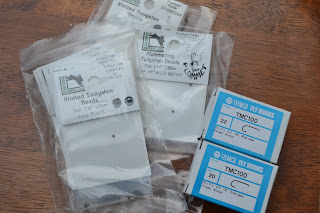Baetis have taken a back seat to the Midge here on the Eagle in the last few weeks. It is still a useful attractor nymph along with Eggs and small Stones.
Less is more in winter
Everything is smaller in winter.
The days are shorter, making for a small feeding window and the water is lower as flows slow to a creep and turn absolutely Gin clear. The deep hole from July is usually 75% smaller in the cold months here on my home freestone, obviously effecting the depth and speed of my rigs. The tippet gets smaller to match the available naturals which happen to be on the extremely teenie side for the next 3 or 4 months. The low clear water combined with the lack of vegetation in the drift allow trout to see a higher percentage of available microscopic bugs but you can scare low water trout easier by showing them too much. I believe the menu of small appetizers narrow a trouts focus, helping them see small bits better, but it also makes that steak sandwich stand out on a buffet table of jelly beans.
It takes me back to my roots on Spring Brook in Caladonia NY where if your size 22 was the wrong shade of the right color you were screwed. This little spring creek was where I discovered midge fishing with super small patterns, long fine leaders and tippet for technical trout. Being a spring fed creek we fished it all year long but especially in the winter when the tribs had no fish in them. I learned a lot from that place.
Miss this place
Winter also begins to blow around my tying studio (that is what they call them in "tieland" nowadays) Cold weather patterns are served up #18-24 with little to no bling and super small beads. Low clear water means fish will have a great advantage noticing all the imperfections in an anglers presentation but I believe they also see bobbers and split shot better. I use small bobbers during the winter and in certain conditions I color the bottom with a black sharpie. Eliminating the bobber and using a small piece of yarn or better yet nothing at all has huge benefits if you can play that game.
Try hiding your bobber in a floating nymph in the winter.
Never tried it, but I own a couple that I must have spun up during some bout with the voices in my head.
Split shot is a vital tool when it comes to getting nymphs into a zone where the fish are but in the winter it can be too heavy as well as too noticeable. I fish at least one bead head fly in my winter rigs, sometimes two, and I always tie with tungsten, mostly black in color. A very large percentage of the junk falling from the vise during fourth season is tied on TMC 100 or TMC 101 light wire dry fly hooks with small 1.5mm-2.0mm slotted tungsten beads.
Yep those are light wire dry fly hooks for nymph patterns.
I like slotted beads in 1.5mm but you can find a small plummeting tungsten beads. The metallic brown one makes for a sexy PMD in the summertime.
Just a touch of flash. Use a good dubbing with some guard hairs like Hare Plus from Hareline and you can skip putting legs on your smallest nymph patterns.
Carry On
Book a Trip








No comments:
Post a Comment